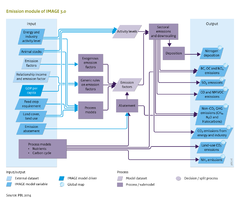Emissions: Difference between revisions
Jump to navigation
Jump to search
Oostenrijr (talk | contribs) m (Text replace - "NOx" to "NO<sub>x</sub>") |
Oostenrijr (talk | contribs) No edit summary |
||
| Line 4: | Line 4: | ||
|InputVar=Energy and industry activity level; Feed crop requirement; Animal stocks; Land cover, land use - grid; Emission abatement; GDP per capita; | |InputVar=Energy and industry activity level; Feed crop requirement; Animal stocks; Land cover, land use - grid; Emission abatement; GDP per capita; | ||
|Parameter=Emission factors; Relationship income and emission factor; | |Parameter=Emission factors; Relationship income and emission factor; | ||
|OutputVar= | |OutputVar=CO2 emission from energy and industry; CO and NMVOC emissions; Non-CO2 GHG emissions (CH4, N2O and Halocarbons); BC, OC and NOx emissions; SO2 emissions; Nitrogen deposition - grid; | ||
|Description=Emissions of greenhouse gases and air pollutants are major contributors to environmental impacts, such as climate change, acidification, eutrophication, urban air pollution and water pollution. These emissions stem from anthropogenic and natural sources. Anthropogenic sources include energy production and consumption, industrial processes, agriculture and land-use change, while natural sources include wetlands, oceans and unmanaged land. Better understanding the drivers of these emissions and the impact of abatement measures is needed in developing policy interventions to reduce long-term environmental impacts. | |Description=Emissions of greenhouse gases and air pollutants are major contributors to environmental impacts, such as climate change, acidification, eutrophication, urban air pollution and water pollution. These emissions stem from anthropogenic and natural sources. Anthropogenic sources include energy production and consumption, industrial processes, agriculture and land-use change, while natural sources include wetlands, oceans and unmanaged land. Better understanding the drivers of these emissions and the impact of abatement measures is needed in developing policy interventions to reduce long-term environmental impacts. | ||
|ComponentCode=E | |ComponentCode=E | ||
|FrameworkElementType=interaction component | |FrameworkElementType=interaction component | ||
}} | }} | ||
Revision as of 10:51, 1 July 2014
Parts of Emissions
| Component is implemented in: |
Components:and
|
| Projects/Applications |
| Models/Databases |
| Key publications |
Key policy issues
- How will emissions of greenhouse gases and air pollutants develop in scenarios with and without policy interventions, such as climate policy and air pollution control?
- What synergies between climate policy and air pollution control can be identified?
